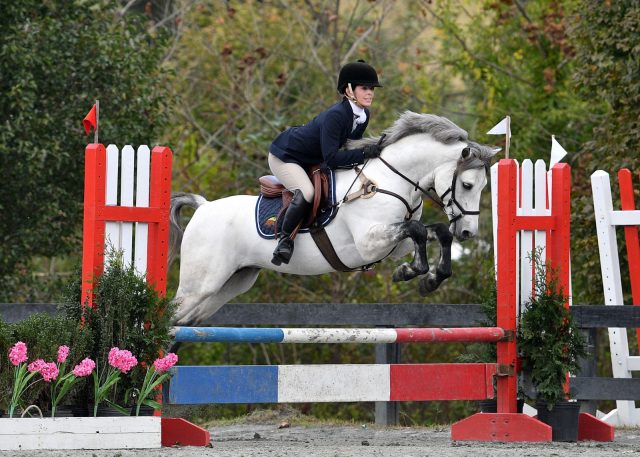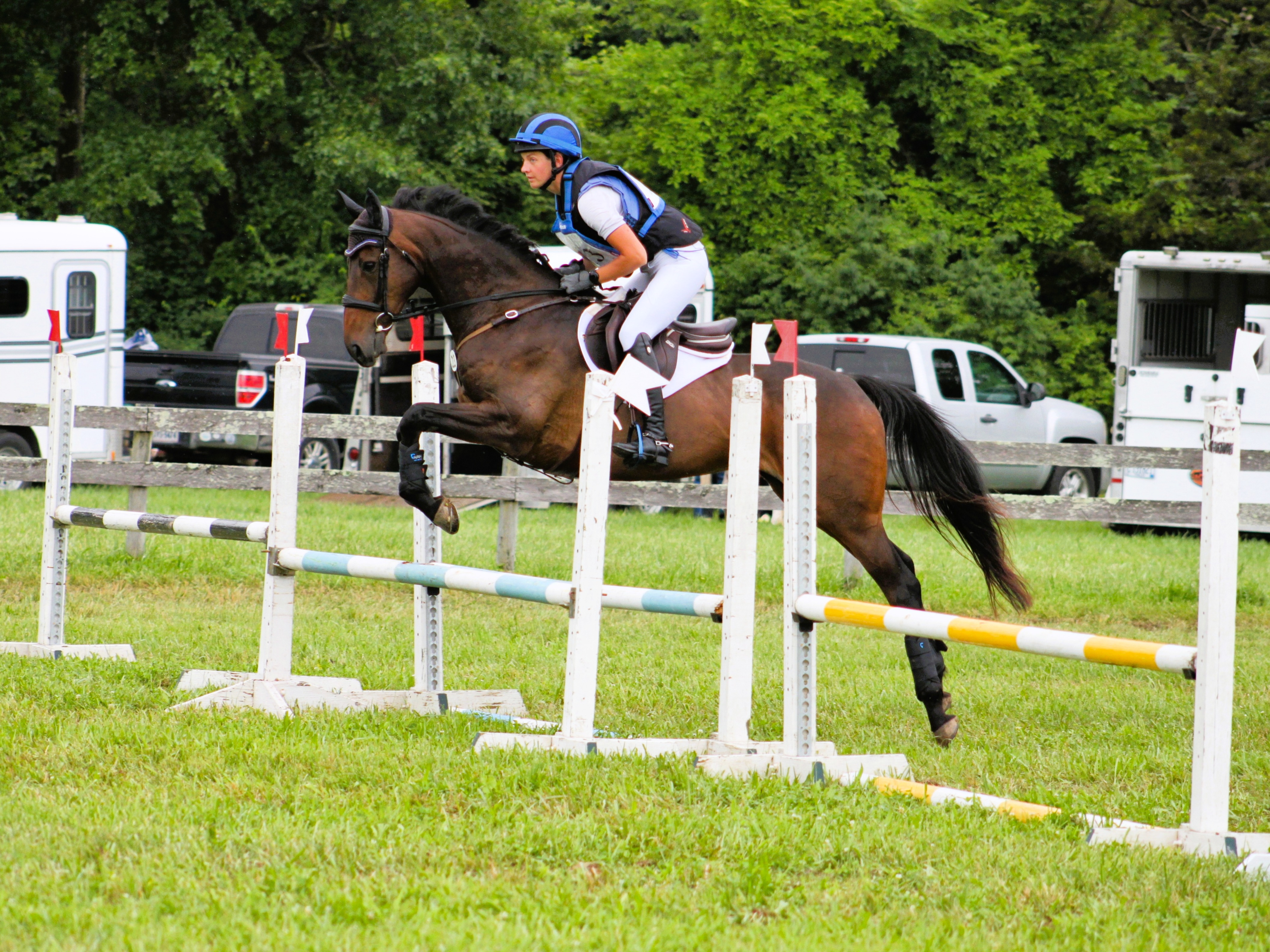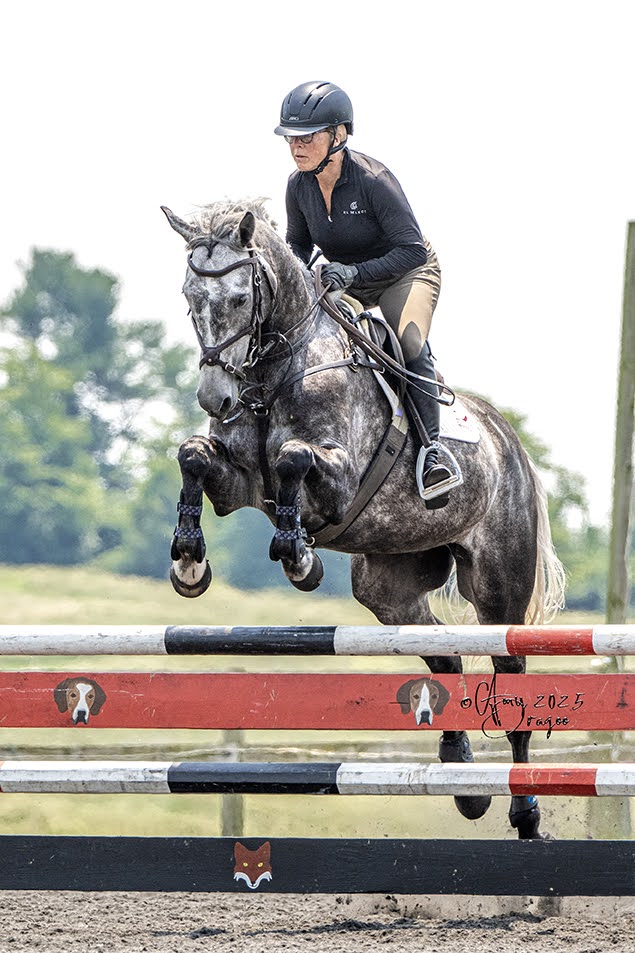Charles Caramello is John H. Daniels Fellow at the National Sporting Library and Museum in Middleburg, Virginia and kindly submitted the following essay on Federico Caprilli, the Italian cavalry officer who revolutionized cross-country riding and jumping circa 1904-06, and his star student, the cavalry officer Piero Santini, who published an important trilogy of books in the first half of the 20th century on Caprilli’s Italian School of “forward riding”. This is a remarkable account of the evolution of the “forward seat” over fences that is so natural to riders today. Enjoy!

Major Piero Santini jumping at the Salonika Front in the Great War, 1914-18
Caprilli and Santini
At the turn of the last century, the Italian cavalry officer Captain Federico Caprilli (1868-1907) developed a radically new system for riding across country and jumping fences—a system originally known as the Italian School or Method and later, and more commonly, as the “forward seat.” It spurred a revolution in military equitation and in the civilian equitation that, in a few short decades, would supplant it. Caprilli’s achievement may not have equaled in magnitude those of his contemporaries Einstein and Picasso, but it did equal theirs in originality.
Caprilli based the Italian system on his observation that the horse naturally tends to bascule while free jumping and on his critical insight that the rider, to achieve maximum preservation of the horse and effectiveness in the field, must facilitate that tendency rather than impede it: the rider, in short, accommodates the horse, not just vice versa. A gifted rider as well as visionary horseman, Caprilli not only developed the concept and refined the techniques of “forward riding,” but he also practiced those techniques, to judge from photographs, with near perfection.

Federico Caprilli.
Caprilli died prematurely at age forty, leaving behind him precious little writing on “Il Sistema.” Like masters in many fields, however, he had the good fortune to be survived by brilliant students (and students of students) who not only proselytized his system, but also, in their own writings, fleshed out its details and implications. Caprilli’s early direct and indirect followers included, among others, four international cavalry officers of considerable subsequent influence: Piero Santini, Paul Rodzianko, Harry Chamberlin, and Vladimir Littauer.
Major Piero Santini (1881-1960) was Caprilli’s most ardent and influential disciple and a tireless advocate for his system in the English-speaking world. Perfectly bilingual in English and Italian, Santini published a seminal trilogy of books in the U.S. and England advancing the principles of forward riding: Riding Reflections (1932), The Forward Impulse (1936), and Learning to Ride (1941); he also played important roles in two posthumously published books: The Horseman’s Dictionary (1963) and The Caprilli Papers (1967).1
Caprilli and Santini are joined at the hip in the history of modern outdoor equitation: it is virtually impossible to speak of one without speaking of the other. It is also fitting, but still ironic, that Caprilli and at least his basic principles are widely known, while Santini enjoys far less renown. More important, Santini’s works—representing both Caprilli’s and Santini’s thinking—are now largely inaccessible and unknown, or at least unread, though they once were readily available and widely known and read. The following essay is meant as an introduction to those works.2

Piero Santini.
Santini’s Trilogy
Though the three volumes of Santini’s trilogy share subject, they differ in emphasis and audience. Riding Reflections surveys the theory and application of the Italian Method, and primarily addresses civilians who have not served in military “mounted arms.” More technical in orientation, The Forward Impulse focuses on using the Method to support and benefit from “the natural forward balance of the horse,” and was written for advanced equestrians. Learning to Ride, by contrast, was intended as a primer in “forward riding” for amateur riders—particularly young riders—and those who instruct them.
Riding Reflections (1932)
Riding Reflections, wastes no time—or diplomacy—in defining its audience. Santini divides the equestrian world into civilians (amateurs) and officers of the “mounted arms” (professionals). Since the civilian “in countries where compulsory military service does not exist,” moreover, “is generally an unalloyed dilettante [lacking] the opportunity for systematic and thorough instruction,” Santini refines his taxonomy into three categories: active or reserve officers in “cavalry or field- or horse-artillery”; civilians who have done compulsory service in those arms; and “civilians with no military service to their credit.”
Riding Reflections addresses civilians (or amateurs) in the third, and, to some extent, the second categories: it aims to correct “current defects and misconceptions regarding riding position in those [riders] past the tyro stage and therefore not in need of primary instruction.” In 1932, Santini could posit his underlying distinction between military riders as professionals and civilian riders as amateurs, because “well-organized cavalry schools” still trained officers who were becoming military anachronisms but also were dominating international equestrian competition. That distinction would start to fade by 1936, in The Forward Impulse, and all but disappear by 1941, in Learning to Ride.
Riding Reflections comprises eleven chapters. Santini gives little historical background in them to the development of the Italian Method or its foundational “Italian” or “forward” seat”—at least in comparison with his subsequent Forward Impulse. In the opening chapter, he briefly invokes Caprilli as the founder of a system of horsemanship based on “the principles that a horse should be interfered with as little as possible and that . . . he should move with the freedom and natural balance of a riderless animal.” Santini also introduces a signal theme of his trilogy: the Italian seat is not a “jumping formula,” but “a complete and distinct method of equitation.”
Santini then dissects the Geometry of the Forward Seat in topics ranging from misconceptions to perfection, instinct, and simplicity. Some points introduced here and repeated later include Santini’s dictum that the Italian seat, contrary to popular misconception, “is not based on the short leather”; his opinion that writings on “overcoming, rather than correcting, the defects of the horse . . . would be better employed in studying the defects . . . of the horseman”; and his belief that horse shows not only corrupt Caprilli’s system, but also, “with rare exceptions, contribute nothing to the improvement of breeding and very little to that of horsemanship.”
Santini’s animus toward the show ring introduces a second signal theme of his trilogy: the forward seat is fundamentally a cross-country seat—and only, as an “afterthought,” a show jumping seat. Here, the theme takes shape in a discussion of hunting with hounds. Briefly put, cross-country riding is “the only bona fide sport . . . in which man and horse associate”; hunting is the oldest expression and the epitome of cross-country riding; and the forward seat is “supremely adapted” to hunting. This emphasis on hunting may seem paradoxical, given Santini’s opening distinction between military professionals and civilian amateurs, but it has a historical logic.
Santini’s paean to the hunt, together with his comment that “war and the chase have gone hand in hand through the centuries,” reflect a literary tradition, dating to Xenophon, that treats hunting as training for warfare. Modern Anglophone contributors to the tradition include Lewis Edward Nolan, whose Cavalry: History and Tactics (1853) argues that military horses and riders may gain more from hunting than from manège training; E. A. H. Alderson, whose Pink and Scarlet, or Hunting as a School for Soldiering (1900) offers an extended narrative illustration; and Siegfried Sassoon, whose Memoirs of a Fox-Hunting Man (1928) pairs with his Memoirs of an Infantry Officer (1930).

The birth of the forward seat-Captain Caprilli in 1904.
The Forward Impulse (1936)
The Forward Impulse turns the themes of Riding Reflections to matters of technique: “The main subject of this, my second book on the Italian Method of Equitation,” Santini writes, “is the action of the hand and its relation to the natural forward balance of the horse—the ‘impulso in avanti’ typical of the modern Italian School.” Santini then fleshes out his subject with clear guidelines on “how to balance the horse through engagement of the haunches, enlightened use of the seat, and conscientious elasticity of the rein contact.”3 This book, Santini notes, is “obviously meant for horsemen of mature experience.”
The book is also obviously meant for polemical ends. Shifting from a measured opening into a more passionate and aggressive tone reminiscent of the manifestos of vanguard art movements—especially Italian Futurism—The Forward Impulse advances an agenda consistent with the zeitgeist. Noticeably nationalistic, the book intends 1) to celebrate Caprilli as founder of the Italian school of equitation, 2) to proclaim the school and its methods a revolution, 3) to portray the revolution as a scientific system, 4) to identify the principles of that system, and 5) to rescue those principles from corruption.
The ratios of The Forward Impulse align with that agenda: Chapter I, The Forward Impulse, takes almost half the book, and Chapter I together with Chapter III, Cross-Country on Italian Principles, take far more than half. The remainder comprises five short chapters, two of them “subsidiary chapters . . . on polo and on the side-saddle” likely to prick current readers who identify the former with skilled riding or the latter with Masterpiece Theater: Santini regards polo as “one of the last strongholds of haphazard riding,” and the forward side-saddle as demanding “a technique different in detail but not in essentials” from the cross-saddle.
In the title chapter, “The Forward Impulse,” Santini defines “forward riding as a complete method for both man and horse . . . based on a theory of the horse’s balance and the horseman’s action of the hand [that are] both entirely new.” The method depends on the true “forward seat”—not simply bending forward, but “leaning the torso forward proportionally to pace and effort.” This forward seat, in turn, depends “on what the Italian Cavalry Regulations term the ‘forward impulse,’ and vice versa.” Consequently, Santini argues, “the true forward method must . . . be accepted in its entirely, and not applied piecemeal, or grafted on to other systems.”

Caprilli’s student, Ruggero Ubertalli.
Santini then honors Federico Caprilli as the creative force behind that integrated and indivisible scientific method of riding. A keen technician of equitation but “an even greater student of the horse’s psychology,” Caprilli led a “revolution” whose tenets are now so widely accepted “that we have forgotten their original source.” Based on “a conception of equitation entirely opposed to the so-called ‘classic’ school” and its principle of collection,” Caprilli’s revolution repudiated “all haute école theories . . . as contrary to its own conception of out-of-door horsemanship”: a “natural equitation,” based on “the horse’s natural equilibrium,” that “differentiates Italian equitation from all others.”4
In “Cross-Country on Italian Principles,” Santini elaborates the true use—and false misuse—of the Italian method. The Italian seat, he writes,” is “the antithesis of . . . indoor equitation” and is “par excellence not only a jumping but an outdoor seat.” Importing that outdoor seat into the show ring, particularly for “high jumping,” produced “mannerisms” and “exaggerations” that corrupted Caprilli’s vision. But the corruption, in turn, also provoked the “wholesome reaction against jumping purely for jumping’s sake [marked by] the increase of steeplechases and ‘cross-countries’ [in] our Cavalry School”—a cleansing return to origins.
Basically reversing the premise of Riding Reflections, Santini argues here that “nowadays, the true sporting outdoor horse and the military horse are practically one . . . , military and sporting equitation are basically one . . . , hence the military and sporting (cross-country) seat . . . should . . . be identical.” Thus, reclaiming the seat that enables “forward riding over the enormous drops and almost perpendicular slides of Tor di Quinto,” and purifying it through a Cavalry School “finishing course consisting almost entirely of cross-country work, obligatory hunting . . . , and steeplechasing,” serves not only military riders, but also their civilian counterparts. This point foreshadows the theme of Learning to Ride.

The Slide at Tor di Quinto.
Learning to Ride (1941)
Santini describes Learning to Ride, in its opening pages, as an effort to “crystalize the principles” advanced in Riding Reflections and The Forward Impulse and to establish the “minimum that . . . beginners should know on these lines before taking any active part in field or ring.” Its subject is the “tuition of the rider,” rather than the “instruction of the horse.” One could say that Riding Reflections and The Forward Impulse introduced the forward seat to otherwise experienced riders, while Learning to Ride introduces the seat to neophyte riders and provides their instructors a guide for teaching it.
Learning to Ride rests on two latent premises that explain its departure from its source books as well as its lengthy proposal of “rules for a riding competition” for young riders: 1) civilian riders were ready for “field or ring” only if and when properly trained in the forward seat, whether otherwise experienced riders being retrained or beginning riders being trained; and 2) civilian riders were a fast growing community (and market) of amateurs requiring constant rejuvenation through recruitment and training of young riders and through competitions whose rules did not place forward young riders at a disadvantage.
Santini’s sacred mission to convert nonbelievers to the truth of forward riding, put differently, merged with his more secular goal of advancing vital amateur equestrian sports in a world losing its professional mounted cavalry. He sought “to produce civilian cross-country riders and not troopers,” and to help those riders realize “the possibility of enjoying the greatest sport of all in the certainty that their mounts will enjoy it with them”—“the ultimate aim of all good horsemen.” This focus on riders for the well being of horses—“keeping horses calm and saving unnecessary wear and tear”—clearly echoes Caprilli.

Caprilli’s student Harry Chamberlin.
Not surprisingly, simplicity and economy emerge here as Santini’s principal themes. “Simplicity [is] the motto of our method,” Santini writes, sometimes expressing simplicity as economy of means—“all that is necessary, but no more than is necessary”—and sometimes as what we now might call mindfulness: “that economy of physical and nervous energy which is one of the basic principles of our method,” an economy that enables “good riding—in the sense of comfort and freedom for horse and man and saving of nervous and muscular energy.”
Together with those themes, also not surprisingly, Santini declares any school of dressage comprising “exercises based on avowedly artificial balance’’ as irrelevant, indeed antithetical, to “a system”—forward riding—“devised solely for cross-country purposes.” Insistent on that purpose, Santini regards “any training not directly and continuously aimed at open air activities of some kind not only useless but deleterious to both horse and rider,” and so cautions instructors, archly, that there is “not much sense . . . in imparting even the most elementary instruction under any roof but that of the sky.”
Santini’s archness, in general, can be harsh: here, he disparages grooms who “shorten cheek pieces until the poor animal’s facial expression is one of grinning idiocy,” and advises course designers that a ditch should not “resemble the handiwork of grave diggers.” But it also can be gentle: children under ten should not show, but rather should ride ponies (“or even a donkey”) bareback in fields: “A few slight falls, and corresponding bruises, under these conditions, not only will fail to affect the nerve of an ordinary child no matter how young, but if he is at all ‘game’ make him all the keener.” Only helicopter parents could take offense.
In the end, Santini’s trilogy extends beyond equitation per se, reflecting not only the flux and uncertainty of the entre deux guerres moment, but also the evolution in European culture over that extended moment from nostalgia to aggression to guarded hope. Riding Reflections, only fourteen years after the Great War of 1914-1918, approaches the reflectiveness of an elegy; The Forward Impulse, in the heart of a politically tumultuous decade, deploys the bombast of a manifesto; and Learning to Ride, confronting a new and still nascent war, merges the pedagogy of a guidebook with the passion of an equestrian gospel for the next generation.
Endnotes
1Santini’s trilogy comprises Riding Reflections. New York: Derrydale Press, 1932. Revised edition, London: Country Life, 1950; The Forward Impulse. New York: Huntington Press, 1936. Revised edition, London: Country Life, 1951; and Learning to Ride. New York: Greenberg Publisher, 1941. Revised and retitled The Riding Instructor. Country Life: 1952. His posthumous works are Lida Fleitmann Bloodgood and Piero Santini, The Horseman’s Dictionary. London: Pelham Books, 1963; and Captain Federico Caprilli, The Caprilli Papers: Principles of Outdoor Equitation. Translated and edited by Major Piero Santini. London: J.A. Allen, 1967. Xenophon Press reissued The Forward Impulse and Learning to Ride in 2016; the other titles are long out of print, but copies can be found on the specialty book market. In addition to books, Santini published numerous articles, letters to the editor, and other short pieces, many of them in The Chronicle of the Horse.
2In the service of accurately representing Santini’s thinking and of conveying his distinctive voice, the essay quotes liberally from his works.
3Frances A. Williams. “Editor’s Preface.” The Forward Impulse (Franktown, VA: Xenophon Press, 1916), p. i.
4The method “requires a natural horse,” whose muscles and senses are developed “by exercise, not exercises, in the open,” as well as a rider with neither an “agitated” nor “rigid” hand—the latter an error of those who “practise forward riding without . . . the forward impulse in their minds.”
Part two of this essay discusses works published after Santini’s death including The Horseman’s Dictionary and The Caprilli Papers. Stay tuned!




















































